Python
> Diogommr
> Learn...
> Code / Development
Snippet List - 30 seconds of python. Advanced Python made easy - Quick Code - Medium. Python is an object-orientated language that closely resembles the English language which makes it a great language to learn for beginners.
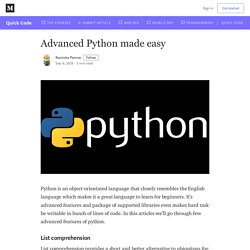
It’s advanced features and package of supported libraries even makes hard task be writable in bunch of lines of code. In this articles we’ll go through few advanced features of python. List comprehension List comprehension provides a short and better alternative to ubiquitous for loops. It is used in context of iterations where we need to perform an operation on every element of the list. Syntax :- [some_operation(element) for element in sequence] - returns list of elements.
Example :- We are concatenating the lists returned from two list comprehensions. Slicing Slicing is used to extract a continuous sequence/sub sequence of elements from a given sequence. List[start_index : end_index : step_size] - returns list of elements. - default start_index is 0. - default end_index is -1. - default step_size is 1. Lambda lambda arguments : expression Map.
Markdown
First Python Notebook — First Python Notebook 1.0 documentation. Almost Everything in Python!!! – Head to Head…
A curated list of Python frameworks, libraries, software and resources.
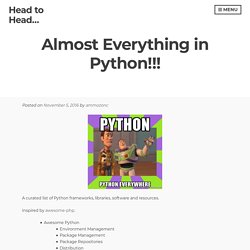
Inspired by awesome-php. Environment Management Libraries for Python version and environment management. p – Dead simple interactive Python version management.pyenv – Simple Python version management.venv – (Python standard library in Python 3.3+) Creating lightweight virtual environments.virtualenv – A tool to create isolated Python environments.virtualenvwrapper – A set of extensions to virtualenv. Package Management Libraries for package and dependency management.
Defining Python Source Code Encodings. This PEP proposes to introduce a syntax to declare the encoding of a Python source file.
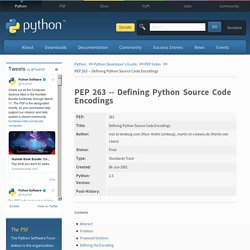
The encoding information is then used by the Python parser to interpret the file using the given encoding. Most notably this enhances the interpretation of Unicode literals in the source code and makes it possible to write Unicode literals using e.g. UTF-8 directly in an Unicode aware editor. In Python 2.1, Unicode literals can only be written using the Latin-1 based encoding "unicode-escape". This makes the programming environment rather unfriendly to Python users who live and work in non-Latin-1 locales such as many of the Asian countries.
Home – Quantitative Economics. Python: How To Reduce Memory Consumption By Half By Adding Just One Line Of Code?
Python-tutorials. Calendar-in-python. Techbeamers.
Python Anywhere
VPS Providers. Cool Projects. Projects.raspberrypi. Learn python3 in Y Minutes. Python was created by Guido van Rossum in the early 90s.

It is now one of the most popular languages in existence. I fell in love with Python for its syntactic clarity. It’s basically executable pseudocode. Feedback would be highly appreciated! You can reach me at @louiedinh or louiedinh [at] [google’s email service]
Wagtail
Django. Flask. Web & Servers. PDFs. Microsoft Word. Metadata. Word Documents. Audio. Browser Automation. Web Scraping. Keyboard. Time / Date. Computer Vision. NLP. Data Science. Data Visulization. SQLite. Encryption. App Dev. Games. Kivy. Multimedia. PyQT. Tkinter. Standard Library. OOP. PyGame. Regular Expressions. Modules. How to Delete a File in Python. Article_page_one_by_one By John Paul Mueller While you can use Python to delete information from files, you may find you no longer need the file at all.
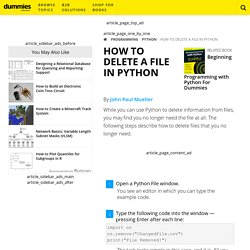
The following steps describe how to delete files that you no longer need. article_page_content_ad Open a Python File window.You see an editor in which you can type the example code.Type the following code into the window — pressing Enter after each line:import os os.remove("ChangedFile.csv") print("File Removed!
") article_page_content_bottom_ad. How to find Python List Installed Modules and Version. The main strength of the Python is, the wide range of external libraries are available.
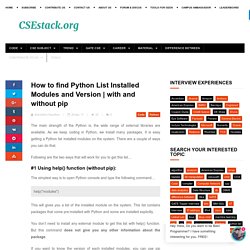
As we keep coding in Python, we install many packages. It is easy getting a Python list installed modules on the system. There are a couple of ways you can do that. Following are the two ways that will work for you to get this list… #1 Using help() function (without pip): The simplest way is to open Python console and type the following command… help("modules")
Automate the Boring Stuff with Python. Satwikkansal/wtfPython: A collection of subtle and tricky Python examples. One Stop for Python Programming Resources.
One Stop for Python Programming Resources.
Learn it Faster: The Entire Python Language in a Single Image. Short Bytes: What if you had to study one single page to get the complete idea of a programming language?
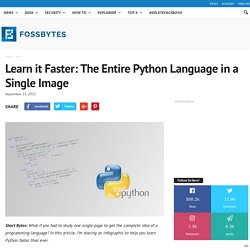
In this article, I’m sharing an infographic to help you learn Python faster than ever. This is the follow up of my article The Entire JavaScript Language in a Single Image. Today, we are sharing The Entire Python Language in a Single Image infographic with our fossBytes readers. A China-based developer Yusheng has created this brilliant infographic that encapsulates the entire Python 3 programming language in a single image.
Python is one of the most popular programming languages and it’s a skill every programmer must possess. Yusheng’s mind map is here for you in easily understandable format that will help you to brush up your memory. You can find the image online on GitHub, or save it directly from below.
Introduction — Python 101 1.0 documentation. Welcome to Python 101!

I wrote this book to help you learn Python 3. It is not meant to be an exhaustive reference book. Instead, the object is to get you acquainted with the building blocks of Python so that you can actually write something useful yourself. A lot of programming textbooks only teach you the language, but do not go much beyond that. I will endeavour to not only get you up to speed on the basics, but also to show you how to create useful programs.
Intermediate Python — Python Tips 0.1 documentation. Python Resources. Welcome to Python for you and me — Python for you and me 0.3.alpha1 documentation. Using a consistent Python Style: Follow the PEP8 Style Guide.
Published on Dec. 24, 2016 Python is a great programming language, interpreted by the great Python interpreter implemented in C, hence the speed of execution.
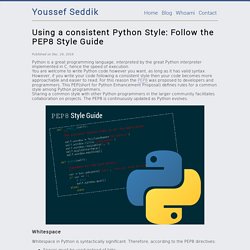
You are welcome to write Python code however you want, as long as it has valid syntax. However, if you write your code following a consistent style then your code becomes more approachable and easier to read. For this reason the PEP8 was proposed to developers and programmers.
An (“Evolving”) [List] of Python Resources. Python has become one of the most important programming languages used for predictive analytics and machine learning.
![An (“Evolving”) [List] of Python Resources](http://cdn.pearltrees.com/s/pic/th/evolving-resources-foresightr-137510968)
For those who are unfamiliar with Python, the following resources are useful for learning the language. These resources appear in a (mostly) alphabetical order.
Essential Python Cheat Sheet by sschaub - Cheatography.com: Cheat Sheets For Every Occasion. A brief Python language reference for Python 2.6+ / 3.0+. Python functions string conversion statement boolean tuple Download the Essential Python Cheat Sheet 2 Pages.
Scientific python cheat sheet by IPGP. Pure Python Types a = 2 # integer b = 5.0 # float c = 8.3e5 # exponential d = 1.5 + 0.5j # complex e = 4 > 5 # boolean f = 'word' # string Lists a = ['red', 'blue', 'green'] # manually initialization b = list(range(5)) # initialization through a function c = [nu**2 for nu in b] # initialize through list comprehension d = [nu**2 for nu in b if b < 3] # list comprehension withcondition e = c[0] # access element f = e[1: 2] # access a slice of the list g = ['re', 'bl'] + ['gr'] # list concatenation h = ['re'] * 5 # repeat a list ['re', 'bl'].index('re') # returns index of 're''re' in ['re', 'bl'] # true if 're' in listsorted([3, 2, 1]) # returns sorted list z = ['red'] + ['green', 'blue'] # list concatenation.
I wish I knew these things when I learned Python. I sometimes found myself asking myself how I cannot know simpler way of doing “this” thing in Python 3. When I seek solution, I of course find much more elegant, efficient and more bug-free code parts over time. In total(not just this post), the total sum of “those” things were far more than I expect/admit, but here is the first crop of features that was not obvious to me and learned later as I sought more efficient/simple/maintainable code. Dictionary keys() and items() You could do various interesting operations in keys and items of dictionaries.
10 awesome features of Python that you can't use because you refuse to upgrade to Python 3. 30 Python Language Features and Tricks You May Not Know About. 1 Introduction Since I started learning Python, I decided to maintain an often visited list of "tricks".
Any time I saw a piece of code (in an example, on Stack Overflow, in open source software, etc.) that made me think "Cool! I didn't know you could do that!
" I experimented with it until I understood it and then added it to the list. This post is part of that list, after some cleaning up. Each trick or language feature is demonstrated only through examples, with no explanation. The list is very roughly ordered by difficulty, with the easier and more commonly known language features and tricks appearing first. A table of contents is given at the end.
Making Python run faster: a case study · AF. December 25, 2016 As a langauge, Python was originally designed for faster development cycles, and not for execution speed.
This principle remains very much alive today, and although it has garnered the language a bad reputation for its sluggishness, there are a few very common antipatterns that you can avoid to make your Python run faster. In this post, I will demonstrate some of these ideas by exploring solutions to a very simple algorithm: calculating the average (or, to be more precise, the arithmetic mean) out of a list of integers.
For our experiment, we’ll time our functions on three lists of different lenghts, as the size of the list will affect our solution’s runtime. We can start by generating some test data: import randomrandom.seed(1) lengths = [10, 100, 1000]lsts = [[random.randint(0, 100) for _ in range(length)] for length in lengths]# [[17, 72, ...another 8], [83, 48, ...another 98], [3, 60, ...another 998]] With our three test lists, we can start writing up solutions.
Improve Your Python Skills – dbader.org. 10 python idioms to help you improve your code - enlist q. If you have ever tried to learn a new language (not a programming language), you know that we always think in our native language before we translate it to the new language.
This can lead to you forming some sentences that don’t make sense in the new language but are perfectly normal in your native language.
7 Tips For Python Performance. When you begin using Python after using other languages, it's easy to bring a lot of idioms with you.
Web2py vs others. Table of Contents — How to Think like a Computer Scientist: Interactive Edition. This interactive book is a product of the Runestone Interactive Project at Luther College, led by Brad Miller and David Ranum. There have been many contributors to the project. Our thanks especially to the following: This book is based on the Original work by: Jeffrey Elkner, Allen B. Downey, and Chris MeyersActivecode based on SkulptCodelens based on Online Python TutorMany contributions from the CSLearning4U research group at Georgia Tech.ACM-SIGCSE for the special projects grant that funded our student Isaac Dontje Lindell for the summer of 2013.NSF The Runestone Interactive tools are open source and we encourage you to contact us, or grab a copy from GitHub if you would like to use them to write your own resources.
Learn Python - Free Interactive Python Tutorial. Primer on Python Decorators. In this tutorial on decorators, we’ll look at what they are and how to create and use them.
Local and Global Variables in Python. One of the basic elements of programming languages are variables.
Python Progamming Made Easy. Getting started. Python Tutorial. Object-Oriented Programming in Python(The Complete Guide)
One of the ways to simplify a program is to1 use objects, classes and functions.
Pyinstaller/pyinstaller: Freeze (package) Python programs into stand-alone executables. 30 Python Language Features and Tricks You May Not Know About. The Magic Behind Python Generator Functions – Hacker Noon. The best free resources to Learn Python Programming Language and Python Frameworks. Python Tutorial, Python Online Tutorial. Pythonforbeginners.com - Learn Python by Example.
@decorators in Python – Hacker Noon. Coodict/python3-in-one-pic: Learn python3 in one picture.
Intermediate pythonista. Karlijn Willems – Medium. Welcome to Python for you and me — Python for you and me 0.3.alpha1 documentation. Python: The Dictionary Playbook. I so often come across various kinds of boilerplate code regarding dictionaries in Python, that I decided to show some of it here and share the more concise way of performing the same operations. Presenting: The Dictionary Playbook. This one is pretty simple, but I’m amazed as to how it’s missed - finding out if a key exists in the dictionary.
Python Resources. Python Tutor - Visualize Python, Java, JavaScript, TypeScript, Ruby, C, and C++ code execution.
Automate the Boring Stuff with Python. Collection Of 51 Free eBooks On Python Programming - Electronics For You. To use with Raspberry Pi or to program simulation software, here’s bringing 51 super helpful and free ebooks on Python programming that can help you become a python pro. Who knows you end up becoming the next big gaming programmer!
Introduction · A Byte of Python. A Byte of Python · GitBook. GitHub - aerkalov/ebooklib: Python E-book library for handling books in EPUB2/EPUB3 and Kindle format -
PyVideo.org. 10 Basic Python Examples That Will Help You Learn Fast.
Python Tutorial. Python tutorials for beginners.










![An (“Evolving”) [List] of Python Resources](http://cdn.pearltrees.com/s/pic/th/evolving-resources-foresightr-137510968)